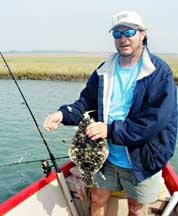 Horseshoe Crabs Get a Little Help from Some Friends
Horseshoe Crabs Get a Little Help from Some Friends
Round and heavy, the moon crept toward horizon, drawing the Bay up like a blanket. The tide rose on Turkey Point until the waves knocked against the jagged chunks of asphalt piled there to keep the shore from washing away. From those waves tumbled those prehistoric monsters known as horseshoe crabs.
Some crept up the beach to burrow into the soft sand, the females to lay eggs and the males to fertilize them. Others landed on their domed backs, legs waving in the air like strands of kelp. They dug their spiked tails into the sand to right themselves, but the sand crumbled away. The stranded creatures began to bake beneath the afternoon sun.
Two were dead by the time two dozen fifth-graders from Edgewater and Mayo elementary schools emerged from the woods. The kids were invited to the private beach by Turkey Point residents Brenda DeLalla and Sharyn Vogel, and led by Sharon Solberg, who warned them to watch out for buried crabs.
Of course, the kids knew the crabs weren’t really crabs. Solberg taught them that when they visited the Carrie Whedon Science Center in Galesville. They’d learned that horseshoe crabs were more like spiders than crabs (but much bigger). They learned that horseshoe crabs have been around since before the dinosaurs and that they are important to the ecology of the Bay — not to mention the regional economy.
Watermen on the Delaware Bay in particular have turned from dwindling stocks of oysters and crabs to fishing for whelks — a popular delicacy amidst the region’s growing Asian population. And nothing makes better whelk bait than the blue blood of horseshoe crabs.
 Like royalty — or aliens from a B-movie — the lowly horseshoe crabs bleed blue. Their blood
Like royalty — or aliens from a B-movie — the lowly horseshoe crabs bleed blue. Their blood
is high in copper, as ours is high in iron, so when it hits the air and oxidizes, it turns a blanched blue.
That blood has another miraculous property. Under laboratory conditions, it congeals around endotoxins. It can be used to test vaccines, donated organs or blood samples. It used to take days to detect meningitis, for example. But the blue blood of horseshoe crabs congeals around meningitis in mere hours.
BioWhittaker, in Walkersville, in Frederick County, is the nation’s leading distributor of the blue blood. They’ve tried to develop a synthetic substitute to no avail.
But the kids from Edgewater and Mayo didn’t want to use the crabs; they just wanted to help them. They began the Memorial Day holiday by picking up the crabs and setting them gently in the water or using long sticks to flip them over. They identified the males by their puffy front claws, and counted every crab, male or female, dead or alive. They found nine, all told — two pairs, mated and burrowed, and three solitary males, besides the two dead crabs.
Sharon Solberg went back the next day, when the moon was fuller still, and counted 162. She wished the kids had been there to see the beach littered with black shells, but she was happy they’d come at all. Happy to see the kids get their hands on the crabs they’d studied and happy to see the joy of discovery in those young eyes.
“That’s what we teachers live for,” Solberg said.
What crabs live for we don’t know, only that after all these years we hope they survive us.
—Brent Seabrook
The Eagles Have Risen
 |
photo courtesy of DNR
Workers from DNR look on with Gov. Glendening and his new wife, Jennifer Crawford, as one of four rescued bald eaglets is returned to the wild. |
Four young bald eagles returned to the wild on Memorial Day, three weeks after they were rescued from a Charles County silt pit where three more had died, mired in quicksand. The too-close encounter with industry had horrified eagle watchers, who’d been rejoicing in gains made by the once-endangered species.
From Sandy Point State Park, Gov. Parris Glendening helped state wildlife biologists release the awesome birds — three feet tall with wings stretching six feet from tip to tip.
“As we pay tribute to the defenders of American freedom this Memorial Day, we also celebrate
our country’s most cherished symbol — the bald eagle — and recognize the heroic efforts of those who saved the eagles’ lives,” Glendening said.
When his turn came, Glendening was confident, despite the outcome of a 1996 release at Patuxent Naval Air Station. On July 4, former President Bill Clinton set free a rehabilitated eagle named Freedom, only to have territorial osprey strike it down.
There was irony in this release as well, for just weeks earlier the Chesapeake Bay Program had celebrated the success of bald eagles in Maryland.
“Improved water quality and the preservation and restoration of bald eagle habitats has allowed the species to once again flourish throughout the Bay watershed,” said Diana Esher in March, when she was acting director of the Chesapeake Bay Program.
But the peaceable kingdom is easily undone, as the Charles County incident reminds us.
Nesting season draws eagles away from the Bay and into the woods along the Potomac River. On one of the bends of the river, seven were found mired in a 10-acre pond used as a silt pit by Maryland Rock Industries. Mixed with pond water, pulverized rock dumped into the pit turned into a thick sludge, trapping the eaglets. It seemed hopeless until a U.S. Park Police helicopter arrived from Washington. Sgt. Ron Galey held the helicopter — known as Eagle 1 — inches above the pond while Sgt. John Marsh and Department of Natural Resources wildlife biologist Bryan King plucked the eagles from the muck. Three of the seven were already dead.
“The rescue effort demonstrated the resourcefulness of our state and federal workers, but more importantly it revealed their strong commitment to working together to achieve a common goal,” Glendening said.
At the Baltimore Zoo, the four live but bedraggled eagles were washed with warm water and fed fluids, vitamins, steroids, antibiotics and anti-fungals. The birds recuperated in a pair of heated stalls.
 |
| Sgt. John Marsh, of the U.S. Park Police, and DNR wildlife biologist Bryan King pluck the eaglets from the muck. |
To prevent their wings from atrophying while they recovered, the eagles were moved to a flight cage at Tri-State Bird Rescue and Research in Newark, Delaware. When they were well enough to release, each bird was outfitted with a satellite transmitter provided by the non-profit organization EARTHSPAN.
State biologists have long banded the legs of wild birds to track their movements, but banding hasn’t allowed them to track those patterns with any frequency. Satellite tracking lets biologists follow every move made by transmitter-bearing eagles.
You can follow the movements of the four eaglets yourself by logging onto www.dnr.state.md.us/wildlife/eaglewatch. The website will be updated daily through June 5 and every Wednesday through May, 2003.
Keeping birds away from the silt pit until it can be drained may depend on technologies nowhere near as sophisticated. The pond could be marked with flags or covered with nets, while a Maryland Rock Industries employee stands on the shore, armed with a cannon or an airhorn.
—Brent Seabrook
 |
| illustration by Gary Pendleton |
Confessions of a Toured-Home Owner
With warm weather come more spectator sports than baseball. The second-favorite American pastime must be home-and-garden touring. That spectator sport rushed through Calvert County earlier this month with the Maryland Home and Garden Tour. This weekend, it’s North Beach’s turn. June 5, historic Annapolis indulges a garden variant in the Hammond-Harwood House’s Secret Garden Tour.
Here, a past host confesses how he got hooked on inviting in hundreds of visitors.
During our first full weekend in North Beach, just after Memorial Day 1997, we took a break from unpacking to take in the town’s annual house and garden tour. Afterwards, we thought that perhaps someday our house could be part of the annual event. Being so new to the area we weren’t sure, but we thought our 1920s’ American Foursquare — a two-story box with four rooms per floor and a full-length front porch — would qualify.
As we got to know people from the house and garden club, we were assured that indeed they would very much like to include our home on the tour. A small town, North Beach has a limited number of places to draw from, even including the surrounding area. So putting together a list of houses for the tour every year is a challenge. Making it harder, many candidates are put off by the amount of work it takes to prepare for 600 guests. No wonder our new friends seemed eager to have us.
I knew that at some point we would follow through, but I kept putting it off. By 2001, I had run out of excuses the organizers would accept.
The biggest pre-tour chore facing my wife Karyn Molines and me was the major plaster repair, followed by repainting, of an interior wall. In late winter 1998, two powerful nor’easters battered the side of our house. The water damage caused plaster to peel away. That work had to be done anyway, so being on the tour gave me the impetus to get the job done, and I was glad of it. But that didn’t stop me from griping.
We also did a top-to-bottom house cleaning, some exterior paint touch-up, yard work and I don’t remember what all. A house built 80 years ago is far from maintenance-free, so there is always work. Once you start looking with a critical eye, the to-do list becomes endless.
When the tour day finally came, we were ready to show off the house. It was a beautiful day,
and we enjoyed meeting people and hearing their compliments. When it was over, we could relax and enjoy having the place to ourselves — looking better than it had in years.
—Gary Pendleton
Flounder Fishing? Keep a Guest Book
 |
photo by Cristi Pasquella
Kevin Grigsby scored on early-caught flounder using Rachel’s Rigs. |
Reports of flatfish invasion of Chesapeake Bay have me
retooling my tackle box. When I tire of trolling for the rockfish that so far have spurned my alluring bucktail [“Classic Rock”: Vol. X, No. 21, May 23], I’m going to rerig my poles for bottom fishing.
Not that the lopsided flounder — which I consider the tastiest fish in the Bay — spend all their time like mudpuppies.
“This is not a very sedentary fish waiting to jump up and pounce, then retreat into mud or sand,” says Maryland Department of Natural Resource’s Martin Gary. “They actively cruise the water column to prey on bait fish. They’re high-level predators, as you can see by their formidable teeth.”
That’s not all the swimming a flounder has to do. Each autumn, the flatties pick themselves up and swim out of Chesapeake Bay. Their ocean-dwelling cousins rise, too. Come October and November, Maryland’s summer flounder have taken up residence off the Continental Shelf, spawning in the deep bottoms. Come March, they’ll be swimming back our way.
How, you may wonder, swims a fish that so loves the bottoms that its downside eye migrates from its whitish underside over to its chromataphore topside? Does it rise up and flap along in the way of rays and skates, which are also bottom lovers?
No, says Gary. Flounder turn like a coin on its side and swim away like any other fish, in short bursts.
Still, anglers seek — and are beginning to find — their flounder on the bottoms. Catches were reported last weekend not only in Maryland’s Atlantic waters, where these salt-loving fish are abundant, but in Chesapeake Bay.
They’re at their densest in the Bay, Gary says, off the eastern edge of the shipping channel, where the bottom drops abruptly from 12 or 15 to 80 and 90 feet.
Flounder range farther north in dry years like this, when the Bay’s freshwater contribution is down. As this dry year advances, Gary says, “I won’t be surprised to see them even at the head of Bay. Certainly they’ll be in the Patapsco River.”
I’ll be looking for my flounder in mid-Bay, off Poplar Island near channel marker 84.
When I go out to hunt for them, Gary hopes I’ll add a new piece of equipment to the flounder rigs and soft crabs in my fishing kit. He and DNR are hoping every flounder fisherman also takes along a guest book. In that catching log, they’re asking you to write down the size of every flounder you catch, whether or not it was a keeper.
Both on the Bay and in the ocean, legal flounder are at least 17 inches long. You can catch eight a day, except when the season closes, between July 25 to August 11, to give the fish a rest.
Recording the size and location of each catch will help assure plenty of flounder flopping not only in Chesapeake Bay but also in the whole coastal fishery. Like rockfish, flounder roam the entire Eastern seaboard from North Carolina to Maine.
And like rockfish, flounder can be done in by too much fishing.
“Back in late 1980s and ’90s, we’d beat it down,” says Gary. In surveys back then, only small fish were showing up. That proved to fisheries managers that fishing was “cropping them off” as soon as they reached the legal minimum. That’s the definition of overfishing, for it soon amounts to no more fish.
“What you’d like to see is broad representation: a whole bunch of year classes, like a neighborhood full of children of different ages,” Gary explains.
Flounder mature quickly. They reach the 17-inch minimum by their third year, and by their second most are ready to spawn. By increasing the minimum size, each class gets to spawn once or twice, ensuring new generations.
DNR’s flounder survey helps fisheries managers know if their plan is working. So, says Gary, “the survey is an incredibly powerful tool for managers and fishermen.”
Find your founder log at www.drn.state.md.us. Look under fisheries, then survey. Print it out and take if fishing with you. After each trip, enter your findings at the same site. To get your copy by mail, call Angel Bolinger: 410/260-8294.
—SOM
Way Downstream …
On Chesapeake Bay, VHF radios crackled over Memorial Day weekend with reports of unusually large numbers of pelicans patrolling the waters within sight of the Bay Bridge. Experienced captains insist it’s unusual to see so many pelicans this far north, especially before summer …
In California, chefs at finer restaurants are advising diners not to order Chilean sea bass, no matter how it’s prepared. They agree with environmental advocates who say the delectable sea bass with the misleading name is endangered from overfishing …
In Oregon, fishermen in love with their prey may get the opportunity to kiss them under new rules requiring resuscitation for endangered salmon. Well, not exactly. Before stressed wild salmon can be returned to the Columbia River, they must be revived by placing them into a tank that pumps oxygen-rich river water into their gills and mouth, the Associated Press reports...
Our Creature Feature comes from Cambodia, where conservationists are talking mermaids in their drive to protect the rare Irrawaddy dolphins. According to the story, a young woman fleeing an arranged marriage with a giant magical python jumped into the rushing Mekong River. She emerged as part dolphin and part human — with beautiful eyes and a come-hither smile.
Unfortunately, only a fraction of the rare dolphins survived after that nation’s civil war in the 1970s, when soldiers used dolphin oil for their motorboats or shot them for target practice. The mermaid hasn’t been spotted recently, but the fable holds that protecting the dolphins brings people good luck.